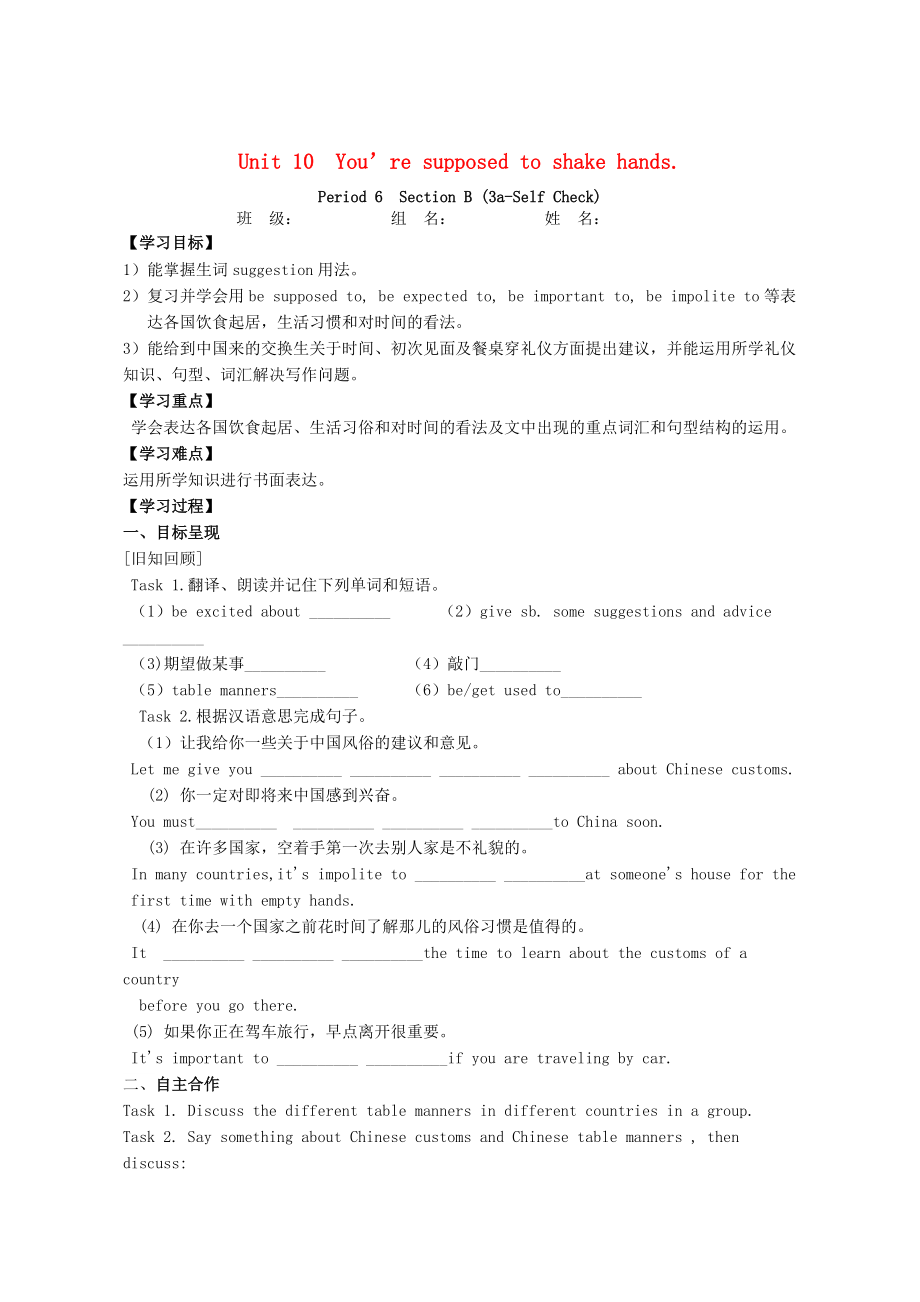《九年級(jí)英語全冊(cè) Unit 10 You’re supposed to shake hands Period 6導(dǎo)學(xué)案人教新目標(biāo)版》由會(huì)員分享���,可在線閱讀��,更多相關(guān)《九年級(jí)英語全冊(cè) Unit 10 You’re supposed to shake hands Period 6導(dǎo)學(xué)案人教新目標(biāo)版(4頁珍藏版)》請(qǐng)?jiān)谘b配圖網(wǎng)上搜索��。
1����、 精品資料
Unit 10 You’re supposed to shake hands.
Period 6 Section B (3a-Self Check)
班 級(jí): 組 名: 姓 名:
【學(xué)習(xí)目標(biāo)】
1)能掌握生詞suggestion用法��。
2)復(fù)習(xí)并學(xué)會(huì)用be supposed to, be expected to, be important to, be impolite to等表達(dá)各國(guó)飲食起居��,生活習(xí)慣和對(duì)時(shí)間的看法���。
3)能給到中國(guó)來的交換生關(guān)于時(shí)間��、初次見面及餐
2�����、桌穿禮儀方面提出建議�����,并能運(yùn)用所學(xué)禮儀知識(shí)�����、句型���、詞匯解決寫作問題����。
【學(xué)習(xí)重點(diǎn)】
學(xué)會(huì)表達(dá)各國(guó)飲食起居���、生活習(xí)俗和對(duì)時(shí)間的看法及文中出現(xiàn)的重點(diǎn)詞匯和句型結(jié)構(gòu)的運(yùn)用�。
【學(xué)習(xí)難點(diǎn)】
運(yùn)用所學(xué)知識(shí)進(jìn)行書面表達(dá)����。
【學(xué)習(xí)過程】
一����、目標(biāo)呈現(xiàn)
[舊知回顧]
Task 1.翻譯�����、朗讀并記住下列單詞和短語��。
(1)be excited about __________ (2)give sb. some suggestions and advice __________
(3)期望做某事__________ (4)敲門__________
(5)
3��、table manners__________ (6)be/get used to__________
Task 2.根據(jù)漢語意思完成句子��。
(1)讓我給你一些關(guān)于中國(guó)風(fēng)俗的建議和意見�����。
Let me give you __________ __________ __________ __________ about Chinese customs.
(2) 你一定對(duì)即將來中國(guó)感到興奮����。
You must__________ __________ __________ __________to China soon.
(3) 在許多國(guó)家���,空著手第
4�����、一次去別人家是不禮貌的����。
In many countries,it's impolite to __________ __________at someone's house for the
first time with empty hands.
(4) 在你去一個(gè)國(guó)家之前花時(shí)間了解那兒的風(fēng)俗習(xí)慣是值得的。
It __________ __________ __________the time to learn about the customs of a country
before you go there.
(5) 如果你正在駕車旅行���,早點(diǎn)離開
5���、很重要。
It's important to __________ __________if you are traveling by car.
二�����、自主合作
Task 1. Discuss the different table manners in different countries in a group.
Task 2. Say something about Chinese customs and Chinese table manners , then discuss:
How does a person behave properly in Chin
6�、a?
Task 3. Work on 3a. Make notes in the chart and say the Chinese customs in English.
Task 4. Work on 3b. Write a letter.
三、展示質(zhì)疑
1) 英語書信的寫法:
稱呼Dear…���, 左起頂格寫���。
正文換行,也要頂格寫��,是信的核心部分��。因此要求正文層次分明、簡(jiǎn)單易懂�����。
祝福的話語�����,正文下?lián)Q行�,頂格寫�,如: Best wishes! Take care! Happy New Year! Happy Birthday! 等��。
結(jié)束語在正文下面的一���、二行處�,第一
7���、個(gè)詞開頭要大寫�,句末用逗號(hào)��。結(jié)束語的寫法 Yours, Your loving…, Sincerely yours、Yours sincerely或Sincerely�;在結(jié)尾語下面的署名必須親自簽名,也不加任何的標(biāo)點(diǎn)符號(hào)����。
2) Useful expressions: 有關(guān)文化禮儀的寫作常用句型
You’re (not) supposed to….
You are expected to…
It’s polite/impolite to…
It’s important to…
You should….
3. Example: 略
Task 5. Self Check 1: F
8、ill in the blanks with the correct forms of the words in the box.
Task 6. Self Check 2: Complete the statements below by themselves.
四���、鞏固構(gòu)建
一�����、用所給單詞的適當(dāng)形式填空��。
1. You are _________ (suppose) to shake hands when you meet a Chinese friend.
2. A knife is _________ (use) for _______(cut) things.
3
9����、. We Chinese eat with chopsticks, while the westerners eat with ___________(knife) and forks.
4. On weekends I feel completely __________(relax).
5. It’s _________(polite) to make a big noise in the school library.
二�、閱讀理解
Sometimes, what you use to eat with may cause trouble in another countr
10�、y.
Luc Cagadoc, 7, is in Grade 2 in a school in Montreal (蒙特利爾), Canada. While having lunch one day last month, Cagadoc was punished by his teacher. According to Cagadoc, it was because he “ate with a spoon and fork, instead of a knife and fork, like most Canadians”.Cagadoc was made to eat alone
11、.
Cagadoc and his family moved to Canada from the Philippines (菲律賓) in 1999. His mother says it is normal for people there to eat with a fork and spoon. She talked to the school principal. But the principal said the punishment was right because Cagadoc was “eating like a pig”.
Soon, many Fil
12��、ipinos in Canada heard about this story through e-mails. They were angry. “We consider this to be a big insult (侮辱) to the Filipino culture,” said Gilbert Asuque, an official from the Filipino Embassy (大使館) in Ottawa.
In Manila, some Filipinos showed their anger in front of the Canadian Embassy.
13�����、 They held up cards that read, “Respect cultural diversity (尊重文化的多樣性)” and “We eat with spoons and are proud of it”.
But the school says that it punished Cagadoc because of the way he ate, not what he used to eat with. The punishment was “in no way aimed at the cultural practices of (Filipino) p
14�����、eople”.
Earlier this month, Canadian Ambassador (大使) to the Philippines Peter Sutherland said that the case was unusual and doesn’t happen often.
Filipinos make up the third largest group of immigrants (移民) in Canada, after people from China and India. About 400,000 Filipino- Canadians live
15���、in the country.
6. What does the underlined word “punish” mean in the passage?
A. 侮辱 B. 點(diǎn)名 C. 懲罰 D. 詆毀
7. Cagadoc thinks he was punished because __________.
A. he wasted too much food
B. he didn’t like the food
C. he used the wrong hand
D. he used a spoon an
16、d fork
8. The school thinks it’s right to punish Cagadoc because __________.
A. he used a spoon and fork
B. he didn’t have good table manners
C. he came from another country
D. he didn’t speak English well
9. Which of the following is NOT true of the passage?
A. Filipi
17、nos usually eat with a spoon and fork.
B. The punishment was not at all to correct the cultural practices of people.
C. Filipinos are the third largest group of immigrants in Canada.
D. Canadians don’t respect cultural diversity.
10. Which of the following can be the best title for
18�、 the passage?
A. Spoon causes trouble.
B. Different table manners.
C. What people use to eat with.
D. Do as the Romans do.
[Homework]
請(qǐng)你根據(jù)下面的內(nèi)容提示,按要求寫一篇介紹英國(guó)風(fēng)俗習(xí)慣的英語短文�����。
內(nèi)容要點(diǎn):
1.英國(guó)人彼此第一次相識(shí)時(shí)�����,一般都要握手���;
2.英國(guó)人在日常生活中經(jīng)常談?wù)摰脑掝}是天氣�����,往往也是第一個(gè)話題。英國(guó)人非常不喜歡談?wù)撃腥说墓べY和女人的年齡���;
3.在英國(guó)購(gòu)物���,人們一般不討價(jià)還價(jià)(bargain) ����;
4.拜訪朋友前要提前通知對(duì)方; 避免在晚上 10 點(diǎn)后打電話到別人家���。
要求:
1. 短文必須包括所有內(nèi)容要點(diǎn)�����,語句通順���,意思連貫�����。
2. 詞數(shù)不少于 90 詞��。
 九年級(jí)英語全冊(cè) Unit 10 You’re supposed to shake hands Period 6導(dǎo)學(xué)案人教新目標(biāo)版
九年級(jí)英語全冊(cè) Unit 10 You’re supposed to shake hands Period 6導(dǎo)學(xué)案人教新目標(biāo)版

